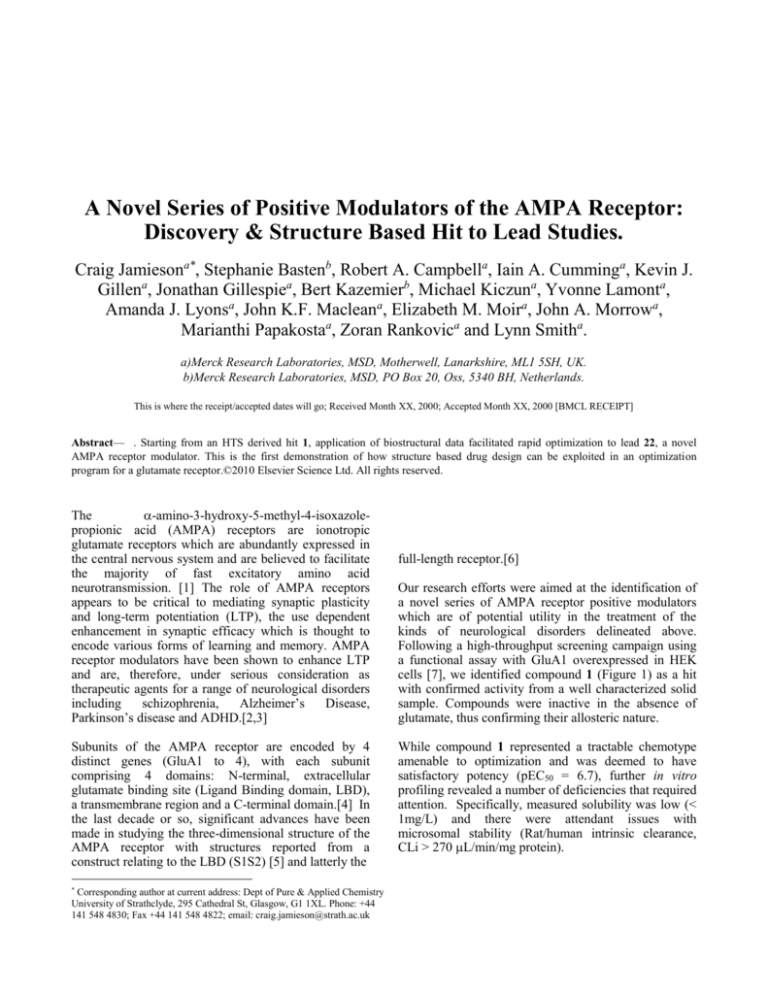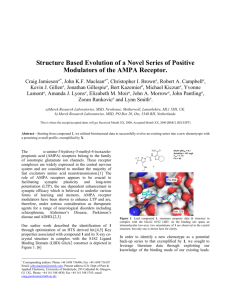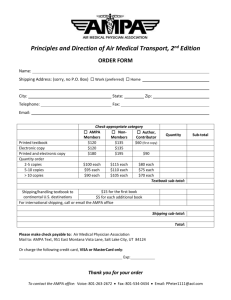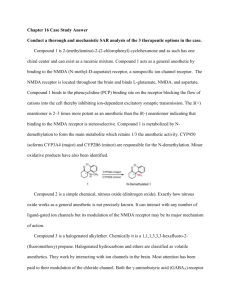
A Novel Series of Positive Modulators of the AMPA Receptor:
Discovery & Structure Based Hit to Lead Studies.
Craig Jamiesona*, Stephanie Bastenb, Robert A. Campbella, Iain A. Cumminga, Kevin J.
Gillena, Jonathan Gillespiea, Bert Kazemierb, Michael Kiczuna, Yvonne Lamonta,
Amanda J. Lyonsa, John K.F. Macleana, Elizabeth M. Moira, John A. Morrowa,
Marianthi Papakostaa, Zoran Rankovica and Lynn Smitha.
a)Merck Research Laboratories, MSD, Motherwell, Lanarkshire, ML1 5SH, UK.
b)Merck Research Laboratories, MSD, PO Box 20, Oss, 5340 BH, Netherlands.
This is where the receipt/accepted dates will go; Received Month XX, 2000; Accepted Month XX, 2000 [BMCL RECEIPT]
Abstract— . Starting from an HTS derived hit 1, application of biostructural data facilitated rapid optimization to lead 22, a novel
AMPA receptor modulator. This is the first demonstration of how structure based drug design can be exploited in an optimization
program for a glutamate receptor.©2010 Elsevier Science Ltd. All rights reserved.
The
-amino-3-hydroxy-5-methyl-4-isoxazolepropionic acid (AMPA) receptors are ionotropic
glutamate receptors which are abundantly expressed in
the central nervous system and are believed to facilitate
the majority of fast excitatory amino acid
neurotransmission. [1] The role of AMPA receptors
appears to be critical to mediating synaptic plasticity
and long-term potentiation (LTP), the use dependent
enhancement in synaptic efficacy which is thought to
encode various forms of learning and memory. AMPA
receptor modulators have been shown to enhance LTP
and are, therefore, under serious consideration as
therapeutic agents for a range of neurological disorders
including
schizophrenia,
Alzheimer’s
Disease,
Parkinson’s disease and ADHD.[2,3]
Subunits of the AMPA receptor are encoded by 4
distinct genes (GluA1 to 4), with each subunit
comprising 4 domains: N-terminal, extracellular
glutamate binding site (Ligand Binding domain, LBD),
a transmembrane region and a C-terminal domain.[4] In
the last decade or so, significant advances have been
made in studying the three-dimensional structure of the
AMPA receptor with structures reported from a
construct relating to the LBD (S1S2) [5] and latterly the
*
Corresponding author at current address: Dept of Pure & Applied Chemistry
University of Strathclyde, 295 Cathedral St, Glasgow, G1 1XL. Phone: +44
141 548 4830; Fax +44 141 548 4822; email: craig.jamieson@strath.ac.uk
full-length receptor.[6]
Our research efforts were aimed at the identification of
a novel series of AMPA receptor positive modulators
which are of potential utility in the treatment of the
kinds of neurological disorders delineated above.
Following a high-throughput screening campaign using
a functional assay with GluA1 overexpressed in HEK
cells [7], we identified compound 1 (Figure 1) as a hit
with confirmed activity from a well characterized solid
sample. Compounds were inactive in the absence of
glutamate, thus confirming their allosteric nature.
While compound 1 represented a tractable chemotype
amenable to optimization and was deemed to have
satisfactory potency (pEC50 = 6.7), further in vitro
profiling revealed a number of deficiencies that required
attention. Specifically, measured solubility was low (<
1mg/L) and there were attendant issues with
microsomal stability (Rat/human intrinsic clearance,
CLi > 270 L/min/mg protein).
From the outset of the program, we had access to
biostructural data using the isolated S1S2 LBD GluA2
construct [5] thus enabling an understanding of how our
compounds interacted with the receptor.[8] Figure 1
depicts hit compound 1 in complex with the S1S2 LBD
GluA2 construct.[9] Although our biological assay used
the GluA1 receptor (wild type GluA2 is not permeable
to calcium), in our hands x-ray crystallographic study of
selected compounds in both GluA1 and GluA2
constructs showed the structures to be identical.[10]
Given that structures could be more expediently
obtained with GluA2, we selected this construct for
routine examination. Modulators of the AMPA receptor
bind remotely to the orthosteric site and essentially
stabilize a protein-protein interaction between the
receptor subunits of each ligand binding domain.[11]
Analysis of our X-ray data revealed that the interactions
made with the receptor were primarily hydrophobic in
nature, with key contacts made at the distal ends of the
molecule (CF3 moiety and tetrahydrobenzothiophene
system). From consideration of the biostructural data,
three principal regions of the molecule were targeted
(shown in red, green and blue) in order to address the
solubility & metabolism issues (Figure 1).
Modification of the tetrahydrobenzothiophene portion
(shown in blue, Figure 1B) was expected to reduce
lipophilicity and concomitantly improve potency and
reduce propensity for hepatic metabolism. However, it
was also anticipated that modulatory activity at the
AMPA receptor may be negatively impacted by such
changes.
F3C
N
H
N
N
O
H2N
O
mg/L). Other truncated analogues (e.g. 3 and 4) showed
a similar reduction in potency without any improvement
in solubility. Retention of the fused ring system with
incorporation of a heteroatom was next explored in
order to attenuate lipophilicity. Compound 5 displayed
promising activity at the receptor but lacked any
appreciable degree of solubility (< 1 mg/L) or metabolic
stability (human and rat Cli > 270 L/min/mg protein).
Insertion of a basic amine (6) or introduction of a
pendant alcohol (7) led to a more than ten-fold
reduction in potency.
Table 1. Modifications to the tetrahydrobenzothiophene region
N
F3C
H
N
N
O
H2N
O
R1
S
R2
Compds
R1
R2
pEC50a
1
-(CH2)46.7
2
H
H
5.2
3
Me
Me
6.1
4
Et
Me
6.2
5
-CH2-CH2-O-CH26.7
6
-CH2-CH2-NH-CH25.3
7
CH2OH
H
5.5
a
Values are means of two experiments performed in duplicate.
In parallel, the contribution of the tetrahydroindazole
system (shown in green, Figure 1B) to AMPA
modulatory activity was examined (Table 2). Deletion
of the fused cyclohexyl ring (8) resulted in
approximately a 30-fold reduction in potency
presumably due to loss of a non-specific hydrophobic
interaction. Activity could be partially restored by
introduction of a 5-CF3 substituent (9), however again
this was accompanied by low solubility and microsomal
stability (Solubility < 1 mg/L, Cli (human) = 174
L/min/mg protein, Cli (rat) = 200 L/min/mg protein).
A fully aromatic system (10) exhibited promising
GluA1 activity, however, was again compromised by
inadequate solubility (< 1 mg/L) and less than optimal
microsomal stability (Cli (human) = 153 L/min/mg
protein, Cli (rat) = 91 L/min/mg protein). As we
expected from the biostructure of 1, having a correctly
orientated trifluromethyl moiety is essential for activity.
Replacement with a methyl (11) or altering the relative
position (12) gave rise to inactive compounds.
S
Table 2 Modifications to the tetrahydroindazole region
Figure 1. A: Hit compound 1 in complex with S1S2 LBD of GluA2.
Receptor surface is depicted, colored by atom type. Several residues have
been omitted from this and subsequent figures for clarity. B: Highlighted
in green, red and blue are the three regions targeted.
Indeed, stripping back the fused cyclohexyl ring system
to furnish e.g. compound 2 (Table 1) resulted in around
a 30 fold reduction in potency, albeit with improvement
observed in solubility (2 showed kinetic solubility of 10
H
N
R
O
O
S
Compds
pEC50a
R
F F
8
H2N
F
N
N
5.3
F F
a
N
F
9
F
F F
10
5.8
F
F
N
F
6.4
N
N
N
11
12
a
Values are means of two experiments performed in duplicate
N
<4.5
N
F
F
F
N
N
These considerations led to the design of compound 16
which had comparable potency to the original hit. Other
amine derivatives (e.g. 17-19), although more potent
than the progenitor 15, were not as active at the receptor
compared to compound 16. The hydrophilic region
proved to be relatively tolerant of other functional
groups with alcohols typified by 20 and sulfonamide
derivatives such as 21 displaying impressive potencies
but in common with many other members of the series
lacked solubility or microsomal stability.
<4.5
Values are means of two experiments performed in duplicate.
The most effective means of meeting our optimization
goals emerged from modification of the amide region of
1. From consideration of the biostructural data, a
hydrophilic pocket adjacent to the primary carboxamide
motif (highlighted in red, Figure 1B) could be accessed
by suitably functionalized entities. We, therefore,
focused our efforts in making modifications to this
region. Intially, simple carboxamide derivatives were
prepared (e.g. 13, 14, Table 3) which confirmed that
substitution at this position would be tolerated.
Encouraged by these results, we next prepared a number
of more functionalized derivatives with pendant
solubilising groups. Evaluation of compound 15 in the
GluA1 assay showed the compound had modest potency
compared to our progenitor hit 1. However, it was
sufficiently potent to obtain biostructural data (Figure 2)
which revealed that contact with an Asp residue at the
side of the hydrophilic pocket could be further
optimized. We hypothesized that either modification of
the linker length, or removal of one or both of the N,Ndimethyl moieties could be beneficial to potency. In
compound 15, the binding mode of the
tetrahydroindazole region was essentially identical to
that observed with the progenitor compound (1).
Figure 2. Biostructure of compound 15 in complex with the S1S2 LBD
of GluA2.
In the series as a whole, compound 16 displayed the
best balance of solubility (38 mg/L) and microsomal
stability (human Cli = 17 L/min/mg protein, rat Cli =
77 L/min/mg protein). Permeability as measured by
CaCo-2 was deemed to be low, however there was no
indication of efflux (A-B = 34 nm/s, B-A = 55 nm/s). In
vivo pharmacokinetics in Wistar rats (2 mg/kg i.v., 10
mg/kg p.o.) indicated moderate clearance & half life in
the i.v. leg (Clp = 21 mL/min/kg, T1/2 = 3.2 h, Vss = 3.8
L/kg), however, as anticipated from the CaCo-2 data,
observed oral bioavailability was low (7.7%). Brain to
plasma ratio was low (0.05) which was reasoned to be a
function of both the number of hydrogen bond donors
and rotatable bonds present in the molecule.
Table 3. Modifications to the tetrahydrobenzothiophene region
F3C
N
R
HN
H
N
N
O
Compds
13
14
15
16
17
18
19
20
21
O
S
R
Et
cPropyl
-CH2CH2NMe2
-(CH2)3-NH2
-CH2CH2NHMe
-(CH2)4-NH2
-CH2CH2NH2
-CH2CH2OH
-CH2CH2NHSO2Me
pEC50a
6.5
6.2
5.2
6.4
5.7
5.9
5.8
7.3
7.0
X-ray crystallographic data on the complex of 16 with
the S1S2 LBD revealed the binding mode was as
anticipated based on our observations from compound
15 (Figure 3). The propylamine side chain was shown to
project into the hydrophilic pocket as before, but now
forming a salt-bridge with the sidechain of Asp 760.
The biostructural data also suggested that
conformationally constrained analogues of 16 could be
accommodated in the hydrophilic region and this led to
the design and synthesis of analogues 22-25 (Table 4) in
an effort to improve brain penetration and oral
bioavailability.
enhance this important parameter.
Synthetic approaches to the compounds discussed above
are outlined in Schemes 1 to 3. Compounds 1-7 were
prepared through a Gewald cyclisation [12] to prepare
the requisite tertrahydrobenzothiophene systems (27)
followed by HATU mediated coupling to furnish
compounds 1 to 7.
NH2
O
NH2
O
O
a
1
R
1
R
H2N
2
S
R
Comparing 22 and 23 shows a preference for the (R)
stereochemistry on the pyrrolidine ring system. This
was consistent with our expectations based on the
conformation of the propylamine moiety required to
facilitate the salt-bridge with Asp 760. The azetidine
analogues 24 and 25 show similar potencies at GluA1
compared to 22.
N
H
N
N
O
Compds
O
S
O
8-12
O
29
pEC50a
6.6
23
NH
5.8
6.5
Amide derivatives 13 to 25 were accessed as depicted in
Scheme 3. Starting from cyclohexanone, Gewald
cyclisation furnished the aminothiophene ester 30.
Amide coupling provided intermediate 31 which was
deprotected by acidolysis. Subsequent HATU mediated
amide formation provided amides 13 to 15 and 20/21. In
the case of 16 to 19 and 22 to 25, a Boc protected
diamine derivative is employed in the coupling step
with the desired amine unmasked in a final TFA
deprotection step.
O
6.2
O
O
O
a
a
H
N
Het
S
28
O
H2N
b
Scheme 2. Reagents and conditions: a) bromoacetyl bromide, Et3N,
CH2Cl2, rt, 94%; b) azole derivative, NaH, DMF, 0° to rt, 14-49%.
S
H
N
O
H
N
Br
NH
25
H2N
S
O
H
N
R
1-7
Compounds 8 to 12 were synthesized in a two step
fashion from the available amino thiophene derivative
28 (Scheme 2). Acetylation with bromacetyl bromide
followed by alkylation of the appropriate azole
derivative furnished the requisite target molecules in an
expedient fashion.
H2N
22
24
2
F
2
a
R
1
R
S
O
Scheme 1. Reagents and conditions: a) sulfur, cyanoacetamide,
diethylamine, EtOH, reflux 23-51%; b) 3-trifluoromethyl-4,5,6,7tetrahydroindazol-1-yl)-acetic acid, PS-CDI, W, 120°C, 10-53%; c)
TFA/CH2Cl2, rt, 23% (for 6).
H2N
F3C
N N
27
Table 4. Constrained analogues of compound 16.
R
HN
F F
b, c
R
26
Figure 3. X-ray structure of 16 in complex with the S1S2 LBD of GluA2
H
N
Values are means of two experiments performed in duplicate
R
N
H
H
N
d, e
S
N
N
S
30
Further profiling of 22 indicated that the compound had
both reasonable solubility (20 mg/L) and microsomal
stability (human Cli = 41 L/min/mg protein, rat Cli =
50 L/min/mg protein). Assessment of permeability in
the CaCo-2 assay suggested that absorption might still
be an issue (A-B = 19 nm/s, B-A = 22 nm/s). In vivo
pharmacokinetics in rat (2 mg/kg i.v., 10 mg/kg p.o.)
indicated that 22 had low clearance and a reasonable
half-life (Clp = 2.3 mL/min/kg, T1/2 = 3.8 h, Vss = 0.5
L/kg) and significantly improved brain exposure (brain :
plasma ratio = 1.03).
However, measured oral
bioavailability was still low (3.8%) indicating that
conformational constraint alone was not sufficient to
H
N
b
H2N
O
F
F
O
31
F
O
S
N
N
F
F
O
13-25
F
Scheme 3. Reagents and conditions: a) sulfur, tert-butylcyanoacetate,
diethylamine, EtOH, reflux, 95%; b) (3-trifluoromethyl-4,5,6,7tetrahydroindazol-1-yl)-acetic acid, HATU, DIEA, CH2Cl2/DMF, rt, 75%;
c) TFA/CH2Cl2, rt, quant.; d) amine/Boc-diamine, HATU, DIEA, DMF, rt
10-70%; e) TFA/CH2Cl2 (for 16 to 19 and 22 to 25), 15-40%.
In summary, we have demonstrated how hit compound
1 was rapidly optimized to improve physicochemical
parameters and metabolic stability resulting in
compounds such as 16 and 22. A central component of
our expedient optimization trajectory has been the
application of structure-based drug design and is the
first example of its use in a glutamate receptor system.
Compounds such as 22 are useful tools in further
elucidating the role of AMPA receptor modulators in
debilitating neurological disorders such as Alzheimer’s
Disease and Parkinson’s. In the following paper, we
describe how 22 can be further optimized to an orally
bioavailable AMPA receptor modulator with promising
in vivo activity.
References and Notes
1. Kew, J. N. C. and Kemp, J. A. Psychopharmacology
2005, 179, 4.
2 . Marenco, S. and Weinberger, D. R. CNS Drugs 2006,
20, 173.
3 . Zarate, J. and Manji, H. K. Exp. Neurology 2008, 211,
7.
4. Mayer, M. L. and Armstrong, N. Annu. Rev Physiol
2004, 66, 161.
5. Armstrong, N.; Sun ,Y.; Chen, G. Q.; Gouaux, E.
Nature 1998, 395, 913.
6. Sobolevsky, A. I.; Rosconi, M. P.; Gouaux, E. Nature
2009, 462, 745.
7. HEK.GluR1(i) cells were maintained in DMEM
supplemented with 10% fetaclone II, 1% non-essential
amino acids and 150 μg/ mL hygromycin, at 37oC/5%
CO2. Twenty-four h prior to the assay, the cells were
harvested with trypsin and seeded onto Costar 96 well
clear bottomed black plates at a density of 3.5x10 4 per
well. Cells were loaded with 5 μM fluo3-AM in DMEM
media in the absence of hygromycin and incubated at
37oC/5% CO2 for one h. After dye loading, the cells were
washed once with 200 μl of low calcium solution (10 mM
hepes, pH 7.4, 160 mM NaCl, 4.5 mM KCl, 2 mM CaCl2,
1 mM MgCl2, 10 mM glucose) containing 0.625 mM of
probenecid to remove the dye. Then 200 μl of low calcium
solution was added to each well. The Flexstation added 50
μl of glutamate +/- test compound in high calcium solution
(10 mM Hepes, pH 7.4, 160 mM NaCl, 4.5 mM KCl, 20
mM CaCl2, 1 mM MgCl2 and 10 mM glucose) to each well
and the ensuing response was monitored on FLEXstation.
8. Crystals were grown as described in ref 5. Co-crystals
were prepared by soaking test compound (100mM) with
crystals for 24h prior to isolation and data collection.
Coordinates and structure factors have been deposited in
the Protein Data Bank for complexes of compounds 1
(3O28), 15 (3O29) and 16 (3O2A).
9. The Pymol Molecular Graphics System (DeLano
Scientific, Palo Alto, CA, 2002) was used to generate
Figures 1-3.
10 . Maclean, J. K. F. and Kazemier, B. manuscript in
preparation.
11. (a) Sun, Y.; Olson, R.; Horning, M.; Armstrong, N.;
Mayer, M.; Gouaux, E.. Nature 2002, 417, 245; (b) Ptak,
C. P.; Ahmed, A. H.; Oswald, R. E. Biochemistry. 2009,
48, 8594. (c) Sobolevsky, A. I.; Rosconi, M. P.; Gouaux,
E. Nature 2009, 462, 745.
12. Gewald, K.; Schinke, E.; Boettcher, H. Chem. Ber.
1966, 99, 94.










